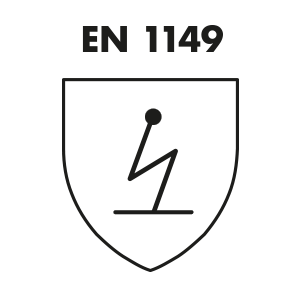- today
- label Guide
- favorite 0 likes
Antistatic clothing - EN 1149 standard
Antistatic clothing protecting the user against electrostatic discharges should meet the EN 1149 standard for clothing providing protection in explosion hazard zones and the electronics industry. Antistatic clothing is also used in the presence of gas and vapor mixtures (explosion groups II A and II B). A characteristic feature of such clothing is the discharge of antistatic charges.
Marking of the EN 1149 standard:

Antistatic clothing is made of materials containing electroconductive elements (fabrics with metal fiber yarn or braided carbon yarn) or of fabrics with an antistatic finish, coated or laminated with a foil.
Clothing protecting against diluted acids, made of anilane fabrics with the addition of electrically conductive fibers, clothing protecting against the effects of chemicals, made of Tyvek non-woven fabric, clothing for the cleaner of liquid fuel tanks, made of polyamide fabric, coated with anti-electrostatic butadiene-acrylonitrile rubber, and waterproof clothing made of antistatic rubber coated fabric with antistatic properties.
The clothing can also be used in fire or explosion hazard zones, provided that proper grounding of the worker is ensured and that the clothing is flame-resistant or non-flammable.
Pursuant to the Framework Directive 89/391 / EEC and the Labor Code, the employer is obliged to provide employees with safety and health protection, whether using technical, organizational or personal protective equipment. The protection of life and health of workers employed in potentially explosive atmospheres is also mentioned in Directive 1992/92 / EC (Atex 137), introduced into Polish law by the ordinance of 8 July 2010 on the minimum requirements for occupational health and safety related to the possibility of occurrence in the workplace. operation of an explosive atmosphere.
In the directive and in PE-EN 600079-0: 2009, you can find the classification of potentially explosive atmospheres, according to which we deal with a zone:
- 0,1,2 for flammable gases, vapors and mists mixed with air,
- 20,21,22 for combustible dusts mixed with air.
We encounter an explosion in an explosive atmosphere when three elements occur simultaneously: a combustible substance, an oxidizer and an energy source. The value of the energy needed to ignite the explosive mixture depends, inter alia, on on the temperature and concentration of vapors in the explosive mixture. In such an area, special precautions should be taken, which are specified in documents: PE-E-05204 and CLC / TR 50404: 2003.
In the explosion hazard zone, use antistatic personal protective equipment, including protective clothing compliant with the provisions of Directive 89/686 / EEC, so as not to contribute to the formation of electrostatic discharges.
Protective clothing must meet certain requirements. These are:
- no static electricity to a degree that could cause discharges from clothing or the human body electrified from it, causing ignition
- prevention of dangerous discharges from the bottom layers of clothing.
It is extremely important to properly test the materials intended for such clothing. Therefore, on the basis of PN-EN 1149, we can distinguish two methods of such testing, which must relate to:
- measurement of surface or volume resistance,
- measurement of charge decay time and screening factor.
These tests relate to electrically homogeneous materials, electrically heterogeneous materials containing fibers, yarns in which the conductive element is placed on the surface and electrically heterogeneous materials containing fibers, electrically conductive yarns in which the electric element is hidden in the yarn structure and is not placed on the surface. Requirements for materials are specified in PN-EN 1149-5: 2009.
Design requirements and requirements for the use of electrically dissipative clothing in a potentially explosive atmosphere when the MEZ value is greater than or equal to 0.02 mJ:
- Electrically dissipating clothing should completely cover undergarments that do not meet the requirements of PN-EN 1149-5: 2009.
- Reflective labels or stripes should be attached permanently in such a way that there are no gaps between the attached items and the material of the garment.
- Conductive parts may only be used if they are completely covered with anti-electrostatic outer material during use.
- Clothing size should be in accordance with PN-EN 340: 2006
- Clothing should be fastened at all times.
- The person wearing this type of clothing should be earthed.
- Clothing should be maintained in accordance with the manufacturer's instructions.
- Wear or heavy soiling of the clothing may result in the loss of its protective properties.
Antistatic clothing should be marked in accordance with PN-EN 340: 2006 and contain the following graphic symbol of the hazard - protection against static electricity (according to ISO 7000-2415) with the number PN-EN 1149-5: 2009. In addition, it should contain the name and address of the manufacturer, a graphic symbol of quantity, a graphic symbol "see manufacturer's information", material composition, maintenance graphics and production date.
